Vegan Globetrotter is supported by our audience. When you purchase through one of our links, we may earn a small affiliate commission. As an Amazon Associate I earn from qualifying purchases. Your cost is not affected.
==================
Hey there, stir-fry enthusiasts and kitchen adventurers! Have you ever wondered about the amazing versatility of woks? Well, you’re in for a treat! In this comprehensive guide, we’re about to take you on a flavorful journey into the world of this versatile cookware from choosing an excellent wok, seasoning your wok and uncover their many uses.
Whether you possess extensive culinary experience or are taking your first steps in the world of cooking, we’re here to demonstrate how this deceptively straightforward kitchen utensil can significantly enhance your culinary prowess. Let’s dive into the wonderful world of woks and discover how they can elevate your cooking to a whole new level.
Choosing an Excellent Wok
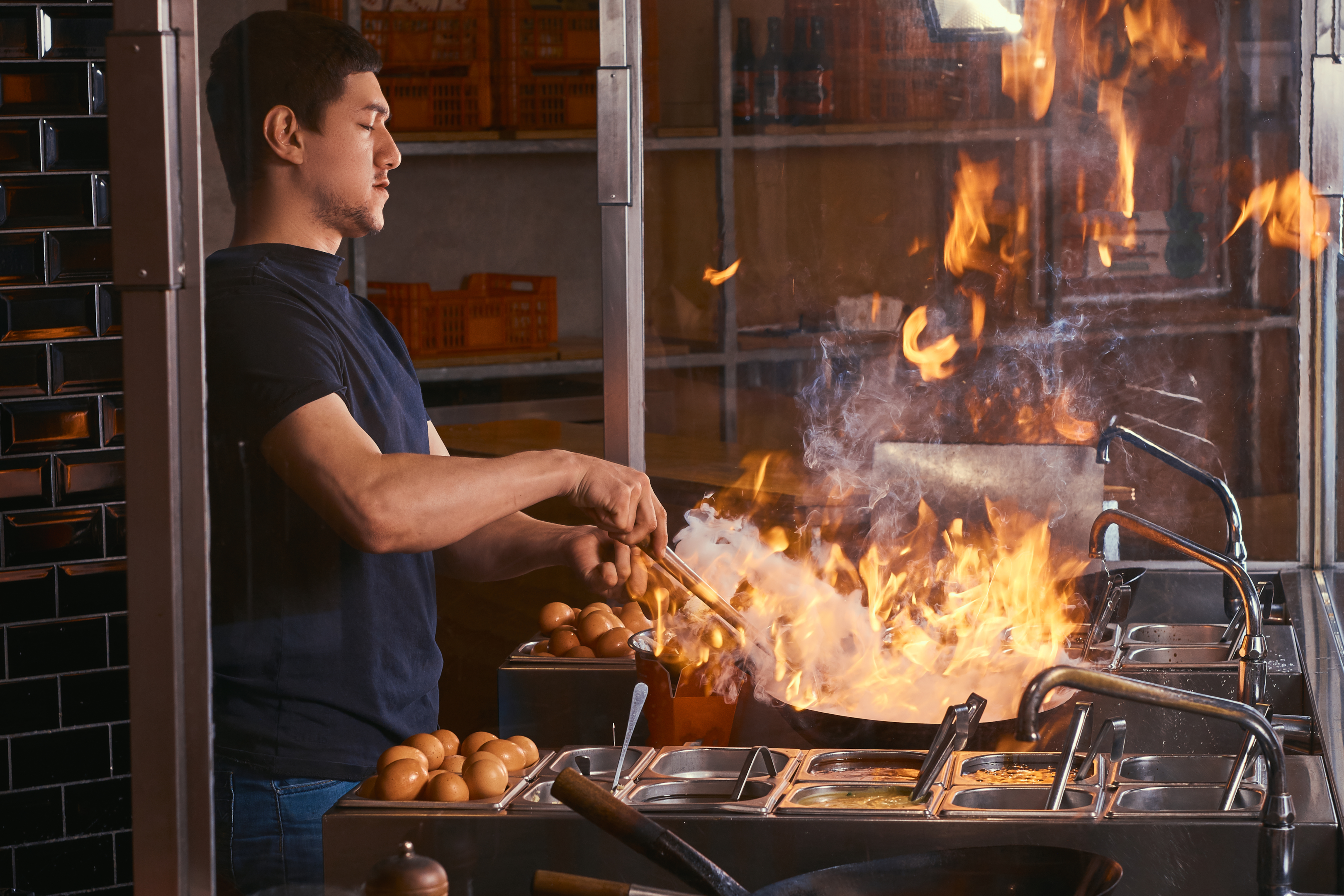
Before we dive into all the fantastic things you can whip up with your wok, let’s talk about the importance of picking the right one. We’re not just talking about any wok; we’re talking about a top-notch wok that fits your stovetop perfectly. When you’re in the market for a wok, keep these key factors in mind:
Material Matters
Look for great wok that are made of either carbon steel or cast iron. These materials rapidly and uniformly distribute heat, making them well-suited for withstanding the high temperatures necessary for wok cooking. When it comes to wok materials, you’ve got a few options to consider. Let’s break them down for you:
- Carbon Steel Wok: This one’s a crowd favorite for a reason. Carbon steel woks heat up fast and evenly, and they’re built to last. The real magic happens when you season them just right – it’s like giving your wok a superpower against food sticking to it. Here’s the deal with a well-seasoned carbon steel wok: the more you use it, the more nonstick it becomes. It’s like a magic transformation! To keep that natural nonstick charm going.
- Stainless Steel Wok: If durability and a pro-looking kitchen vibe are your thing, stainless steel is a solid choice. It’s less porous than cast iron or carbon steel, so it doesn’t demand as much seasoning. Plus, it’s a breeze to clean, thanks to its naturally smooth surface.
- Cast Iron Wok: A cast iron skillet is like the heavyweight champ of the wok world. It holds onto heat for a long time, saving energy in the long run. And here’s the cool part: the more you use it, the better it gets. It becomes more nonstick as it ages, unlike some other materials
Size Up Your Needs
Woks come in all shapes and sizes, but a 14-inch wok is the way to go for most home chefs. Consider a larger one if you’re whipping up feasts for a crowd.
Bottom Line
Woks can have round or flat bottoms. Traditionalists might lean towards round, but a flat-bottomed wok is more stable if you’re using a flat-top stove. Keep in mind that flat-bottom woks might not distribute heat as evenly as their round counterparts.
Handle
A good wok sports different handle types. Go for one with a handle that feels comfortable in your grip, and make sure it’s long enough for those impressive tossing and stirring maneuvers.
Additional Tips for Choosing an Excellent Wok:

- Look for a wok built like a tank, with a sturdy construction that promises durability.
- Steer clear of woks with nonstick coatings, as these can deteriorate over time and release unwanted chemicals into your dishes.
- Let your cooking ambitions dictate the size of your wok. If you’re uncertain, a 14-inch wok is a versatile starting point.
- Consider your budget – carbon steel and cast iron woks might be a bit pricier. However, they represent a valuable investment that will endure and remain reliable over the long haul.
Season Your Wok
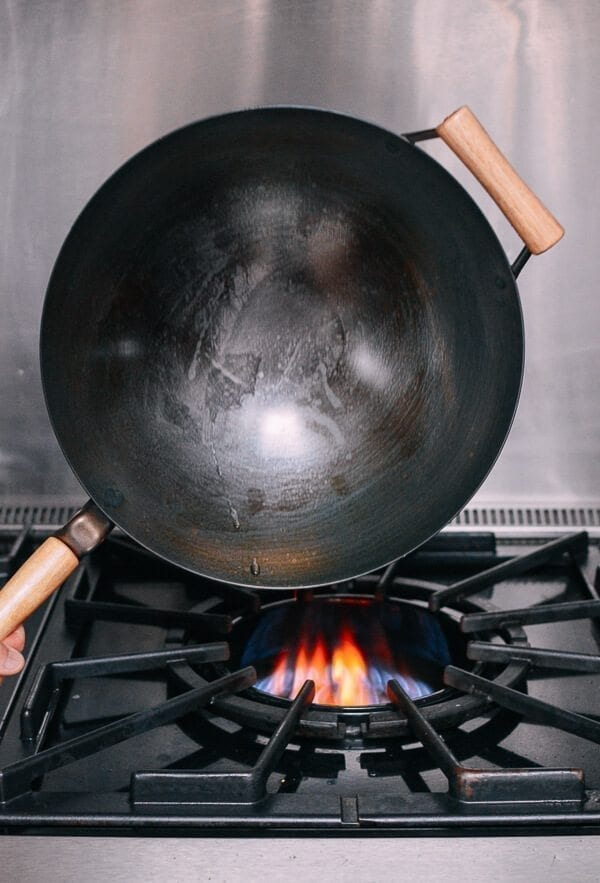
Once you’ve found your dream wok, you’ll want to season it before the cooking adventures begin. This process creates a nonstick surface and guards against rust. To season your wok, heat it over medium heat, add a thin layer of oil, swirl it around to coat, and keep heating until the oil starts to smoke. Take the wok away from the heat source and allow it to cool down. And wipe the wok using a paper towel to remove the excess oils and wash it without using a detergent. Repeat this seasoning process 2-3 times. And you will have a well-seasoned wok. You’ll be enjoying wok cooking whipping up mouthwatering stir-fry creations with the right wok and proper care for years.
Types of Oil You Can Use to Season Your Wok
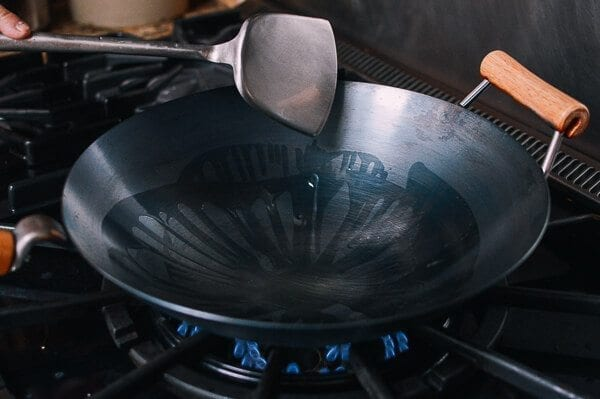
When seasoning your wok, you want oils that can handle the heat without turning into a smoky mess. These oils are your trusty sidekicks for achieving that perfect nonstick surface. Here are some excellent choices:
- Peanut oil
- Grapeseed oil
- Soybean oil
- Avocado oil
- Vegetable oil
- Canola oil
These oils have what it takes to endure the high temperatures of wok cooking without breaking a sweat.
Here’s a tip: steer clear of oils with a low smoke point, like olive oil, sesame oil, and flaxseed oil. They can’t handle the heat and might leave your wok feeling sticky, which is not what you aim for. So, stick to the high smoke point heroes, and you’ll be on your way to wok-cooking greatness!
Here’s a video about seasoning a wok
How to season a wok (basic oil method) By: Yosukata
Difference Between a Wok and a Traditional Frying Pan?
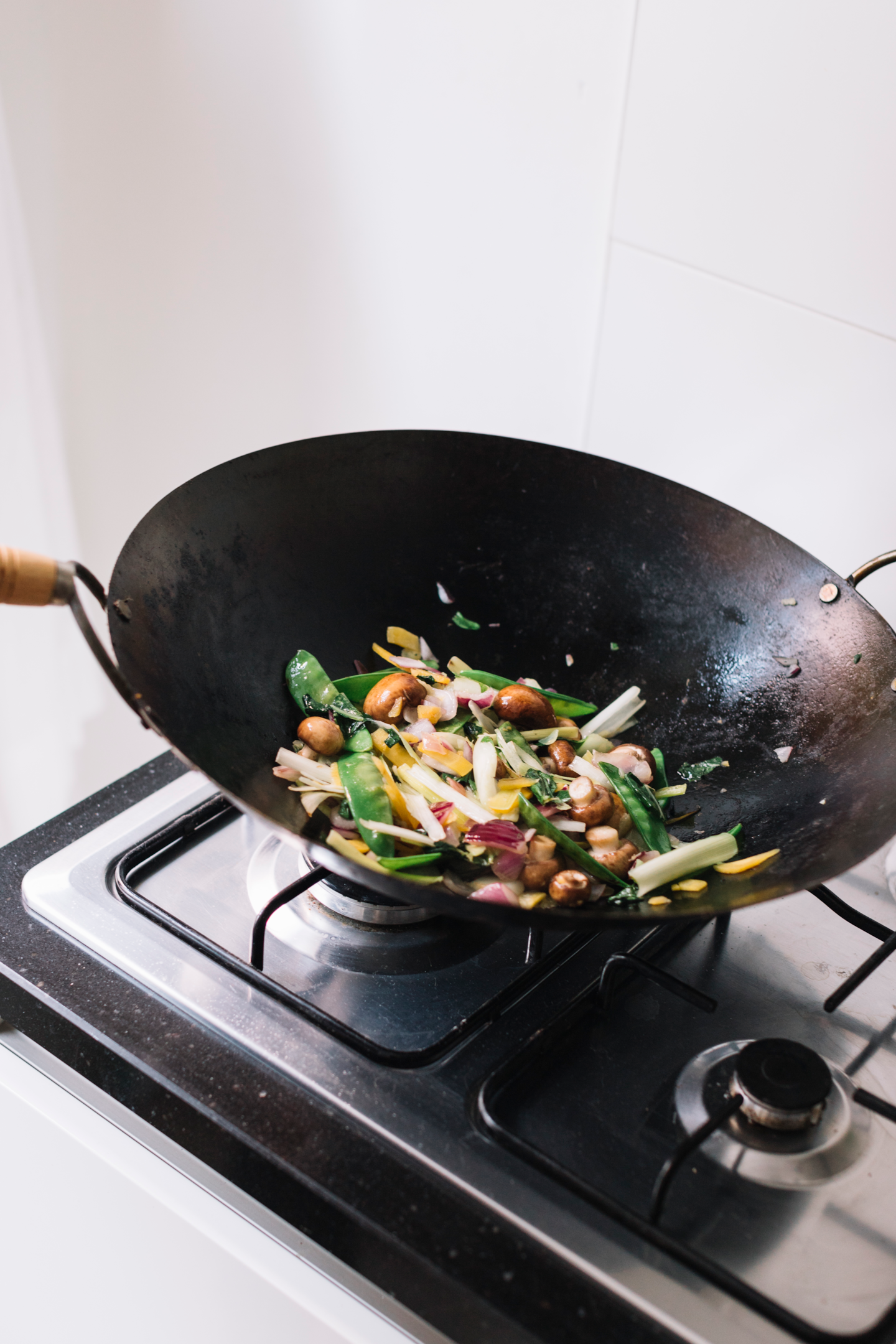
Let’s dive into the differences between wok cooking and using a frying pan when it comes to high-heat cooking on the stovetop. So, your trusty frying pan? It’s all about that flat bottom and slightly sloped walls. Why? That design ensures that oils, sauces, and delicious liquids spread out evenly across the pan’s surface, making it great for high-heat wok cooking.
Now, let’s shift our focus to the wok. It’s got a rounder bottom, which means all those liquids like to hang out right in the center. And those deep, sloping walls? They’re like heat-trapping champions, ideal for wok cooking. This combo in a wok means your food gets cooked faster than in a frying pan. But here’s the twist: the new-age woks have started sporting flat bottoms too.
They’re gaining popularity because they fit perfectly on most standard stovetops, making wok cooking even more accessible. You’ll spot them with two handy side handles or one long, sturdy handle. So, whether you’re a team frying pan or team wok, you have options to suit your wok cooking style and kitchen setup.
What Are Woks Used for?
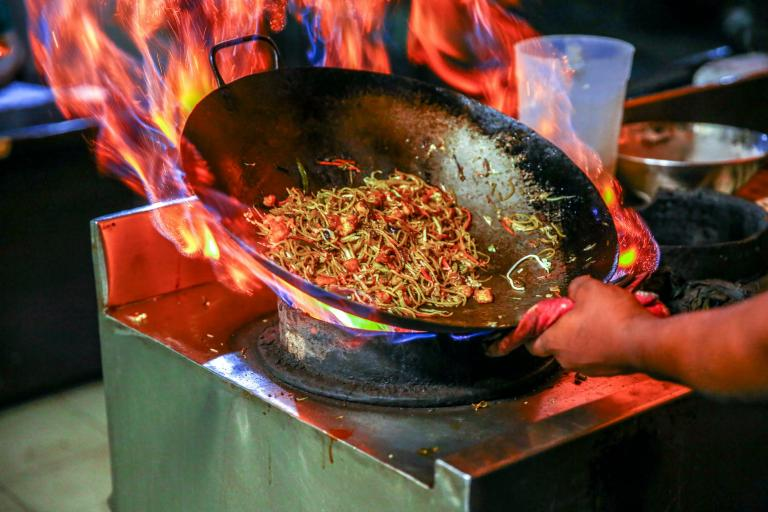
Now that you’ve selected the perfect wok and seasoned it to culinary perfection, you’re ready to embark on an exciting journey into the world of wok cooking. But what exactly are woks used for? Below are the use of woks
Stir-Frying
When you think about what a wok can do, your mind probably jumps straight to stir-frying, and for good reason. The wok is an absolute champion at it. Those sloping walls? They’re like the secret weapon of speedy and efficient food tossing and flipping. Plus, here’s the real magic: the wok’s carbon steel construction is a heat-retention wizard. Picture this: your food takes a spin, getting cozy with that scorching hot pan repeatedly. It’s a steamy affair. This intense heat sears the flavors in, giving your dish that mouthwatering charred essence without any risk of overcooking.
And then there’s the pièce de résistance – the wok’s ability to create a spectacle. As you toss your ingredients over a blazing flame, you get a showstopper of pyrotechnics, which, more importantly, generates that elusive “Wok hei” – the unique flavor that defines a superb stir-fry.
Deep-Frying

You know what’s pretty cool? Woks are pretty fantastic for deep frying, and this trick is a staple in many Asian food cuisines. Well, it’s all about that wok shape! Wok’s sloped sides aren’t just for show – they’re game-changers for deep frying. They let you go easy on the oil while ensuring your food is fully dunked. But here’s where it gets interesting. That conical shape of the wok? It’s like a heat magnet. It gathers all that heat at the bottom, making it the perfect spot for frying. And the best part? It keeps the oil temperature steady as a rock, crucial for getting your deep-fried goodies right. So, with a wok, you’re not just deep frying; you’re deep frying with finesse!
Braising
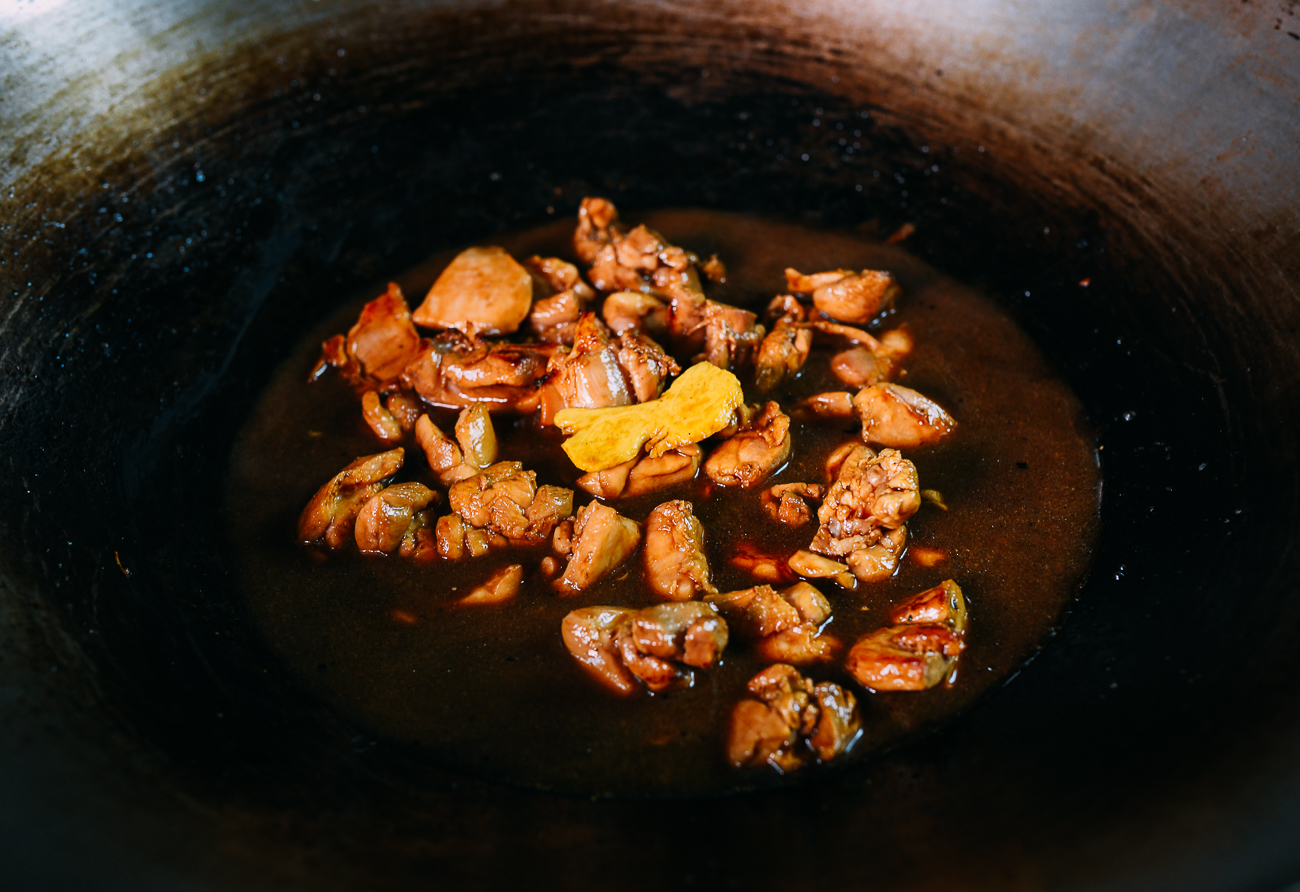
Before stir-frying took the spotlight, braising was the classic choice for wok owners. It’s the technique behind iconic Chinese dishes like mapo tofu, red-cooked pork, and Sichuan water-boiled beef. Unlike quick and dynamic stir-frying, braising takes it slow. It’s all about turning budget-friendly ingredients into delicious, hearty meals to feed a crowd. Plus, it’s perfect for those who prefer a relaxed cooking style with fewer steps. In China, braising isn’t limited to woks; clay and other heavy pots shine, especially for longer, slower cooking without searing upfront. Whether in a wok or another trusty pot, braising brings comfort and flavor to your table.
Steaming
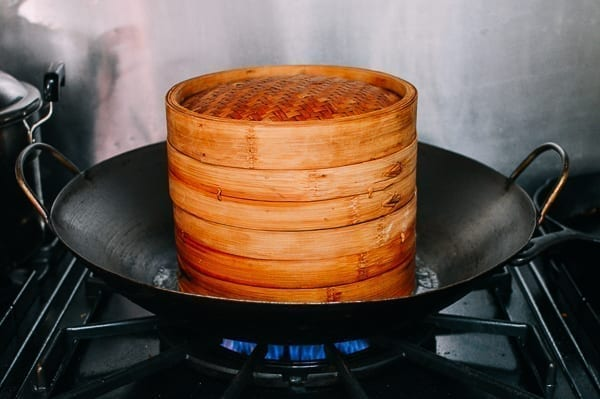
Steaming, a cooking technique much older than stir-frying, has deep roots in Chinese culinary history. We’re talking from ancient times when the Yin Dynasty ruled 1046 BC. They used bronze pots called “zeng” for steaming, a testament to how far back this method goes. If you want to reach even further back, there’s evidence of clay pot colanders being used for steaming some 5,000 years ago.
Here’s the exciting part: your trusty wok is like the MVP of steaming. It’s got the perfect design for it. It’s wide and accommodating so that you can steam just about anything. The wok’s generous width allows you to steam a wide range of ingredients, accommodating various dishes with ease. When you have the right equipment, you can configure multiple steaming setups in your wok, like the bamboo steamer; you can put it in the wok. So, whether you’re steaming steamed rice, your wok is ready to turn out some delicious results!
Conclusion
Woks are truly versatile kitchen tools that can revolutionize your cooking experience. Choosing the right wok that suits your needs and preferences is crucial to fully harness their potential. Properly seasoning your wok is essential to create a natural, nonstick surface and prevent rust; incorporating a wok into your culinary repertoire can elevate your cooking to new heights, allowing you to create flavorful and impressive dishes. So, whether you’re a seasoned chef or a kitchen novice, consider adding a wok to your arsenal and embark on a delicious journey of culinary exploration.
FAQs
How Can I Determine if I Have Successfully Seasoned My Wok?
Examining its surface can tell if you have successfully seasoned your wok. A properly seasoned wok should have a dark black surface with a beautiful matte shade rather than a shiny silver appearance. The dark black surface indicates that the oil has polymerized and created a nonstick layer on the wok’s metal, essential for effective stir-frying and preventing food from sticking.
Is It Possible to Utilize a Wok for Indoor Smoking?
You can use a wok for indoor smoking to infuse your home cooking with a delicious smoky flavor. You’ll need aluminum foil to create a smoking packet and wood chips or sawdust that impart a smoky flavor to do this. Here’s how to go about it:
- Start by lining the bottom of your wok with a layer of aluminum foil. Ensure it covers the entire bottom and has some overhang on the sides to seal the wok later.
- Place a handful of wood chips or sawdust in the center of the foil-lined wok. You can choose from wood chips to customize the flavor, such as applewood, hickory, or mesquite.
- Carefully fold the aluminum foil over the wood chips to create a packet, ensuring it’s well-sealed to trap the smoke.
- Set your wok on the stove and turn the heat to medium-high.
- Once the wok starts to smoke, you can place your food on a rack or a trivet above the smoking packet inside the wok. The smoke will infuse your dishes with that desirable smoky flavor.
Remember to keep a close eye on the process to prevent flare-ups, and always use a well-ventilated kitchen or a range hood to manage the smoke. Employing a wok for indoor smoking can provide an excellent method to infuse your homemade meals with added richness and intricate flavors.
What Are Some Popular Wok Dishes I Can Try?
You can explore various wok dishes, including classics like stir-fried vegetables, fried rice, kung pao chicken, and even fried chicken. You can also add vegetables to enhance your wok dishes’ flavor and nutritional value. The possibilities are endless!
🌱 Explore More With Us! 🍉🌽
Discover the world of vegan and embrace the vegan lifestyle! 🔪
👉 Engaging Content: Follow us on Facebook, Instagram, Pinterest, and Twitter for exciting posts about fruits, veggies, and the vibrant vegan world.
👉 Product Reviews: Check out honest reviews on plant-based products.
👉 Connect with a Community: Join our passionate community of vegan enthusiasts, share your experiences on storing a fresh herbs, and learn from like-minded individuals who love cooking with fruits and veggies!
📌 Find Us on Social Media:
🔹 Facebook: VeganGlobetrotter Join us on our Facebook page, VeganGlobetrotter, where we share mouthwatering plant-based recipes, and tips to inspire your vegan lifestyle.
🔹 Instagram: _veganglobetrotter Follow us on Instagram at _veganglobetrotter to embark on a visual journey of delectable vegan dishes.
🔹 Pinterest: theveganglobetrotter Dive into the world of plant-based goodness and wellness with our Pinterest account, theveganglobetrotter.
🔹 Twitter: VeganGlobetrot Stay up-to-date with the latest vegan trends, insightful articles, and exciting updates by following us on Twitter at VeganGlobetrot.
🌍 Let’s embark on a vegan journey and a celebration of the vibrant world of vegan living! 🌱🌏

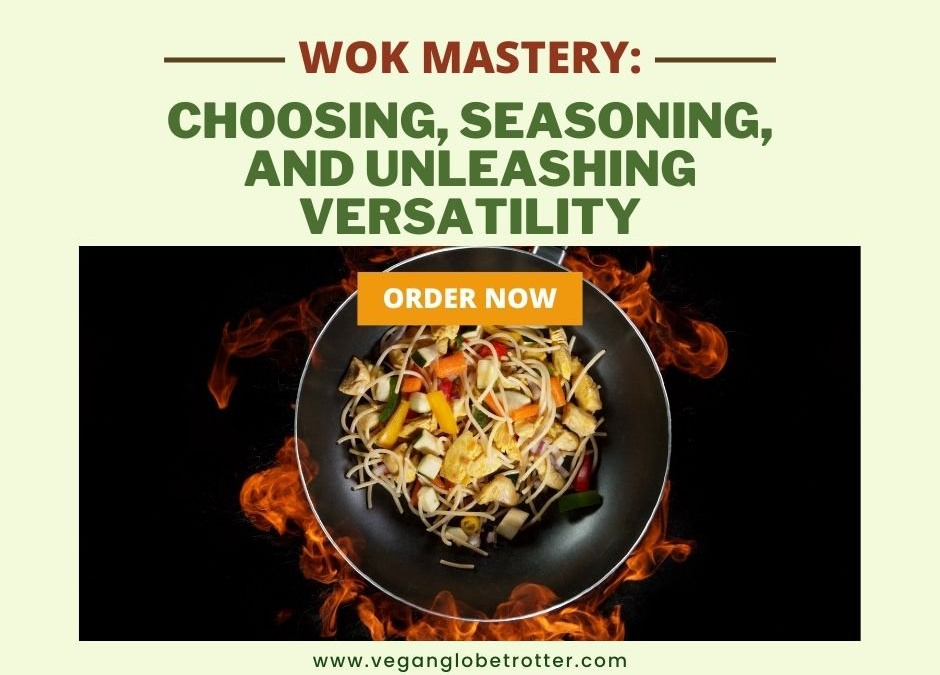
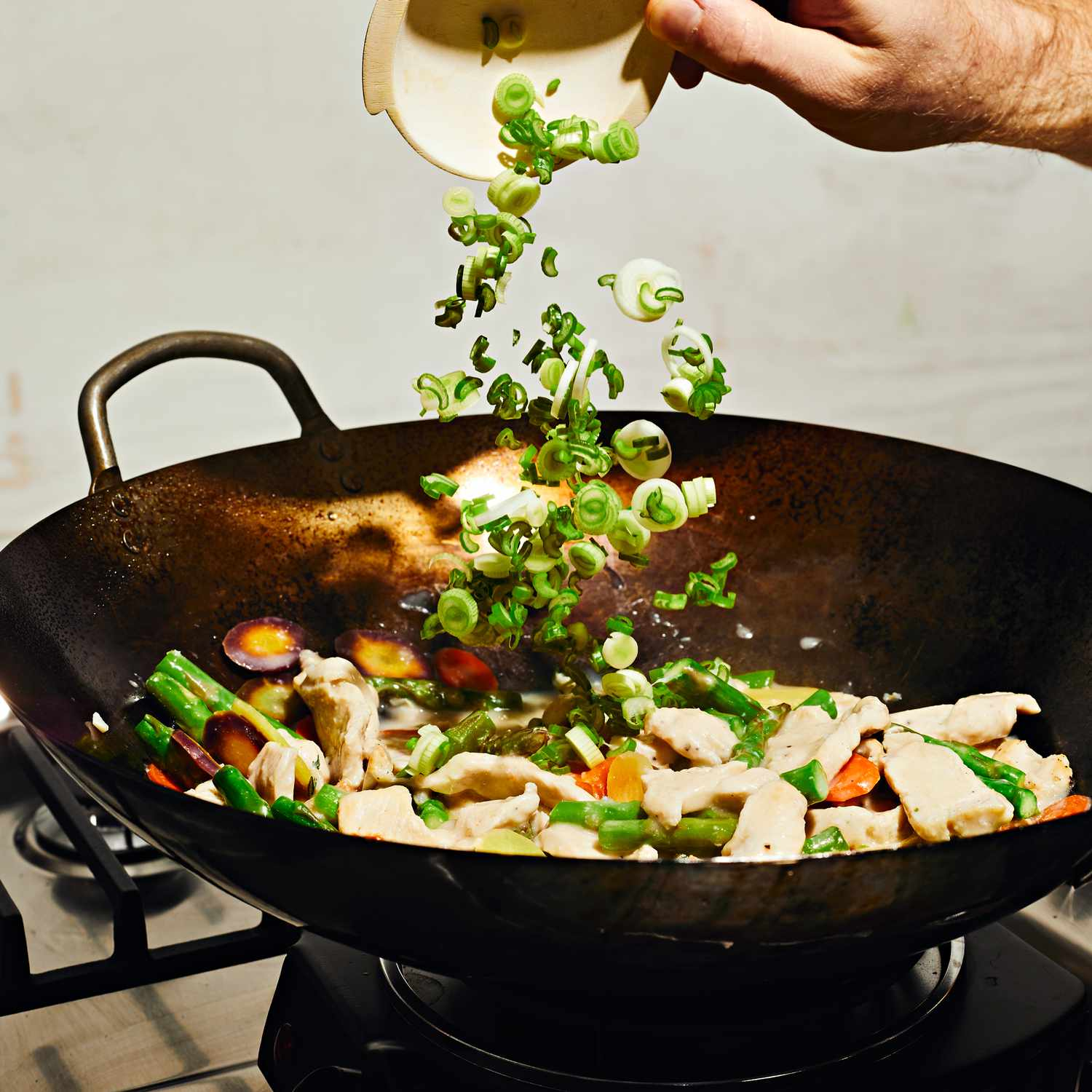



Don't miss out
when new recipes and information are added!
Join our newsletter for free recipes,
healthy living inspiration, and special offers
You have Successfully Subscribed!